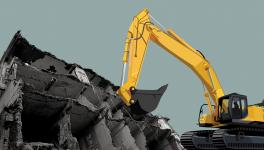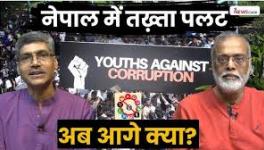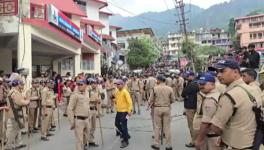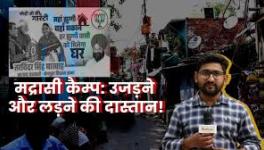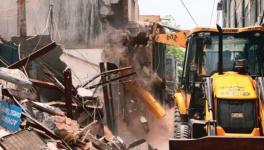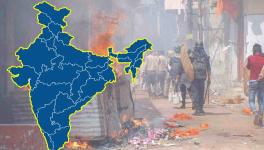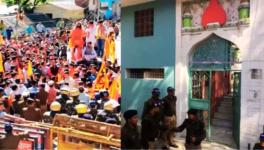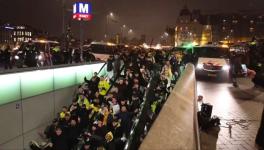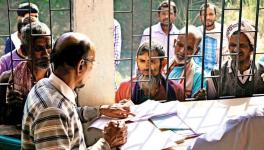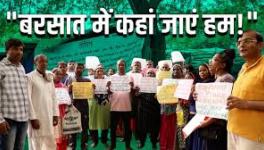Law, Order and Discord: The Haldwani Crisis
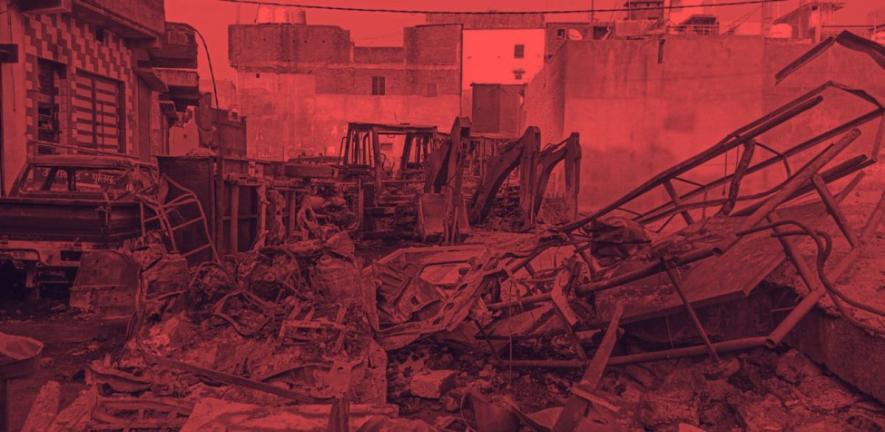
In scrutinising the dire circumstances that have befallen Haldwani, it is important to confront the blatant act of demolishing a masjid and madrasa, an act that has reverberated through the community, resulting in the infliction of horrific atrocities upon local residents.
The administration’s negligence in intervening effectively strengthens a disconcerting hypocrisy, whereby judicial rulings and intelligence reports are disregarded with impunity.
Over the course of a month, tensions escalated in Haldwani following the demolition of Masjid-e-Maryam and Madrasa Abdul Razzakh Zakariya in the Banbhoolpura locality.
Fundamentally, the conflict in Haldwani is over the now-demolished masjid and madrasa, which were situated within Malik Ka Bagicha— a densely populated Muslim enclave in Banbhoolpura.
Municipal commissioner Pankaj Upadhyay affirmed that the mosque and madrasa were constructed on nazul land, designated as government property reserved for public utilities.
These structures, raised in 2002 within Banbhoolpura’s Company Bagh locality, were under the custodianship of Abdul Malik and his spouse, Safia Malik.
However, despite assertions of encroachment on government property, several locals contend that the area where the mosque and madrasa stood had been classified as a ‘category A’ malin basti (slum) in accordance with the Malin Basti Act 2016 ratified by the Uttarakhand Assembly.
Over the course of a month, tensions escalated in Haldwani following the demolition of Masjid-e-Maryam and Madrasa Abdul Razzakh Zakariya in the Banbhoolpura locality
This legislative enactment aimed at regulating and ameliorating the conditions of slum inhabitants residing in unauthorised settlements across Uttarakhand. Notably, ‘category A’ defined settlements entitled to immediate ownership rights under the Act.
As per a notification issued by the Uttarakhand Urban Development Department on December 21, 2016, the location housing the aforementioned plot was categorised as a ‘category A’ malin basti.
This classification raises inquiries regarding the legality of the demolition, particularly concerning the absence of adequate rehabilitation measures. The sequence of events preceding the demolition highlighted collaborative efforts by concerned citizens, including civil society representatives, ulemas and local imams to address the impending crisis.
Following the issuance of a demolition notice by the municipal corporation on January 30, 2024, a delegation convened to present a memorandum to the district magistrate, Vandana Singh, on the subsequent day.
Thereafter, on February 3, a crucial meeting took place between community leaders and district officials, wherein appeals for a legal resolution were earnestly articulated.
During the meeting, community representatives discussed various technicalities disputing the alleged encroachment claims and emphasising their preparedness to pursue legal avenues to establish rightful possession of the land.
They stressed upon the significance of upholding the principles of justice and urged the administration to consider alternative solutions that would address the concerns of both the parties involved.
Amidst the deliberations, Qasmi, a local imam and member of Jamiat-Ulema-i-Hind in Uttarakhand, articulated one sides perspective in these words, “This is a sensitive matter. Several technicalities were also listed where it was claimed that the mosque and the madrasa were not built on encroached land. But above all, we said that we are ready to do whatever it takes to get legal possession or freehold of the land, and the administration should give us some time for that.”
The meeting concluded with a consensus to continue the discussion for legal redress, emphasising the importance of transparency, accountability and respect for the rule of law in resolving contentious issues within the communities of a secular nation.
Sequence of events and violence
The sequence of events leading up to the violent confrontation began on February 4, 2024 when city magistrate Richa Singh, in a social media group, relayed the decision to halt the demolition drive pending a verdict from the Uttarakhand High Court.
Despite this communication, the district administration proceeded to seal the masjid and madrasa in Malik Ka Bagicha later that same day. Subsequently, on February 6, Abdul Malik‘s family lodged a petition in the Uttarakhand High Court, challenging the legality of the demolitions and presenting documentation indicating that the land had been initially leased and later sold to them.
Municipal commissioner Pankaj Upadhyay affirmed that the mosque and madrasa were constructed on nazul land.
Despite ongoing legal proceedings and an upcoming court hearing scheduled for February 14, local authorities opted to carry out the demolitions on February 8, triggering violence between residents and law enforcement agencies.
Tragically, the ensuing violence resulted in the loss of seven innocent lives and left over 100 individuals injured, including police officers and members of the press and media. Moreover, in the name of an investigation, an unnamed first information report (FIR) was registered against 5,000 individuals.
Legality of the demolition and political fallout
In response to the demolitions, a plea challenging the legality of the anti-encroachment drive was filed in the Uttarakhand High Court on February 7, 2024.
The court promptly issued a notice to the state government, requesting its response within six weeks. Senior advocate Salman Khurshid, representing Abdul Malik, argued before the court that proper legal procedures were not followed during the demolition.
Khurshid contended that the demolition occurred merely four days after the petitioner received notice, whereas the law permits for a 15-day period to respond.
However, the court refrained from immediately adjudicating on the matter, instead calling for a counter-affidavit from the government. Despite claims by Uttarakhand Chief Minister Pushkar Singh Dhami and the Nainital district magistrate that the anti-encroachment drive was authorised by a court directive, evidence suggests otherwise.
A copy of the Order issued by Justice Pankaj Purohit indicates that the court merely acknowledged the presence of the parties and scheduled the matter for further hearing on February 14, 2024.
This discrepancy raises significant questions about the legality and justification of the illegal demolitions carried out by the local authorities, contributing to a wider political aftereffect surrounding the incident.
Examining root causes of communal tensions
The escalation of communal tensions in Haldwani’s Banphoolpura area brings light to the rooted issues exacerbated by the actions of the demolition authority.
Several locals contend that the area where the mosque and madrasa stood had been classified as a ‘category A’ malin basti (slum) in accordance with the Malin Basti Act 2016.
The senior superintendent of police Prahlad Narayan Meena revealed that 25 individuals were apprehended in connection with the violence, including 12 for attacking the police station, six for incinerating vehicles outside the station and seven for participating in the violence during the anti-encroachment operation. Meena further alleged that the mob seized government ammunition during the assault on the police station.
Eyewitness accounts from residents such as Parveen and Mehreen paint a harrowing picture of excessive force and disregard for human rights. Parveen recounts the sudden arrival of bulldozers accompanied by a heavy police presence, catching residents off-guard.
Attempts by local leaders and residents to negotiate with authorities to halt the demolition were met with brutality, as police resorted to violence, including assaulting women and forcibly entering homes.
“The police brutally attacked Muslim women who were in support of what the rule of law stated. Their voices weren’t heard, they were beaten by lathis,” voiced one protester.
The result of the demolition has further aggravated tensions, with authorities implementing brutal and ruthless measures such as shoot-on-sight orders, curfews, internet shutdowns, school closures and bans on gatherings.
On February 3, a crucial meeting took place between community leaders and district officials, wherein appeals for a legal resolution were earnestly articulated.
Such measures not only infringe upon civil liberties but also deepen communal rifts and perpetuate mistrust between communities. Sumit Hridayesh, a state legislator representing Haldwani, condemned the hasty actions of the administration, emphasising that the violence could have been prevented through dialogue and proper engagement with local stakeholders.
He stated, “All of this could have been avoided. The violence was a result of ‘hasty action’ by the administration.”
The failure to consult with community leaders, including Muslim representatives, before carrying out the demolition, reflects a disregard for democratic principles and exacerbates feelings of marginalisation among affected communities.
In light of these developments, it is imperative for authorities to conduct a thorough investigation into the events leading up to the violence, hold perpetrators of excessive force and human rights violations accountable, and engage in meaningful dialogue with affected communities to address grievances and prevent further escalation of tensions.
The loss of life and property in the wake of the violent confrontation on February 8 is nothing short of horrific. Families are grappling with the irreparable loss of loved ones, while the physical and emotional scars inflicted by the brutality of the clashes continue to haunt the community.
“The brutality unleashed upon innocent civilians, including women and children, is absolutely appalling,” exclaimed a resident, still reeling from the trauma of witnessing the violence unfold.
Beyond the destruction of the physical structures, the demolition has shattered the sense of security and belonging that these religious and educational centers provided to residents.
Despite ongoing legal proceedings and an upcoming court hearing scheduled for February 14, local authorities opted to carry out the demolitions on February 8.
“It is heart-wrenching to see our sacred spaces reduced to rubble, a stark reminder of the callous disregard for our faith and heritage,” lamented another local, struggling to come to terms with the loss.
“The atmosphere of fear and distrust is palpable, as we grapple with the aftermath of this senseless act of violence,” voiced another concerned citizen, echoing the sentiments of many in the community.
The events of February 8 serve as a stark reminder of the fragility of peace and the urgent need for reconciliation and healing. It is imperative for authorities to acknowledge the enormity of the loss and take concrete steps to address the underlying grievances and restore faith in the justice system.
In the face of such adversity, the resilience and unity displayed by the community offer a glimmer of hope amidst the darkness. It is through collective efforts and unwavering determination that Haldwani can emerge stronger from this tragedy, united in its pursuit of justice and peace.
Security, intelligence failures and beyond
The period between January 31 and February 3 saw a series of crucial security inputs allegedly shared by Uttarakhand’s local intelligence unit (LIU) and the state intelligence unit (SIU) with state police officials.
These inputs— purportedly communicated to high-ranking officials including the additional director general (ADG), Law and Order; inspector general (IG) of police, Kumaon Range; and assistant to the director general of police (DGP); as well as senior superintendent of police (SSP), Nainital; and superintendent of police (SP), Haldwani— outlined significant concerns regarding the impending demolition and its potential fallout.
- The first input underscored the risk of retaliation by Hindu groups in response to claims of religion-specific targeting of religious places by Muslim groups.
- The second input emphasised the importance of engaging community leaders in the predominantly Muslim-majority area of Banbhoolpura prior to the demolition.
- The third input recommended strategic measures such as conducting the demolition in the early hours of the day to minimise large gatherings, utilising drone videography for situational assessment, restricting internet services and ensuring the safe removal of religious items from the mosque and madrasa. Despite these warnings, the authorities proceeded with the demolition drive on February 8.
- The fourth input warned of possible protests by Muslim groups, while the fifth input advised the police force to be prepared to deal with women and children being at the forefront of possible protests.
However, on the day of the demolition, municipal corporation officers, accompanied by district police and other security personnel, encountered widespread protests from residents.
District Magistrate Vandana Singh characterised the protests as a “pre-planned” attack, alleging that locals hurled petrol bombs and stones at police officers.
The refusal of SSP Prahlad Meena to comment on the intelligence note raises concerns about the handling of critical information and preparedness for such events.
Although Meena had previously stated that the police were adequately prepared, the situation reportedly spiraled out of control, leading to personnel scattering and violence escalating.
Beyond the destruction of the physical structures, the demolition has shattered the sense of security and belonging that these religious and educational centers provided to residents.
Moreover, the decision to commence the demolition drive in the afternoon, contrary to the intelligence team’s recommendation for an early morning operation, raises questions about the authorities’ adherence to protocol and preparedness for potential unrest.
These loopholes in security and intelligence coordination, coupled with the authorities’ deviation from recommended strategies, highlight systemic failures and underscore the need for accountability and reform within the demolition authority.
Such oversights not only jeopardise public safety but also erode trust in law enforcement institutions, necessitating urgent measures to rectify shortcomings and prevent similar incidents in the future.
Echoes of post-crisis accountability
The outcome of the violence in Haldwani leaves a deep and unsettling resonance, echoing far beyond the physical scars left by the demolition. As the dust settles and the community grapples with the impact and consequences, it becomes evident that this tragedy is not merely a localised incident but a glaring symptom of broader systemic failures.
The harrowing toll of the violence is starkly evident, with lives lost, individuals arrested, and countless others left injured in the chaos. The once vibrant streets of Haldwani now lay deserted, shrouded in an eerie silence that serves as a haunting reminder of the palpable tension that gripped the community.
Amidst the wreckage, questions of accountability and justice loom large. Administrative loopholes, intelligence oversights and legal transgressions have cast a shadow over the events leading up to the demolition, underscoring a contributive assassination of law and order.
As efforts to navigate the plight continue, the establishment of a tribunal to adjudicate on compensation for the damage to property is a tentative step towards accountability.
However, the designation of Abdul Malik as the prime accused and sole bearer of losses serves as a stark reminder that the official thinking is going in the opposite direction.
In the wake of the violence, calls for legal and administrative measures reverberate, demanding a thorough investigation into the circumstances surrounding the demolition.
The judiciary must play a pivotal role in strengthening the legal framework to protect religious sites and prevent the recurrence of such bulldozer politics.
As society grapples with the task of assigning responsibility, a poignant question hangs in the air: Who bears the burden of disrupting the peace of the innocent lives of Haldwani?
Is it the district administration that carried out grave injustice despite a stay Order, or Abdul Malik and other local residents who stood up against this injustice perpetrated against their mosque?
Ayesha Azka is a first-year student at PG Law College affiliated with Osmania University.
Ammarah Ishaq is a second-year student at the University College of Law, Osmania University.
Get the latest reports & analysis with people's perspective on Protests, movements & deep analytical videos, discussions of the current affairs in your Telegram app. Subscribe to NewsClick's Telegram channel & get Real-Time updates on stories, as they get published on our website.









